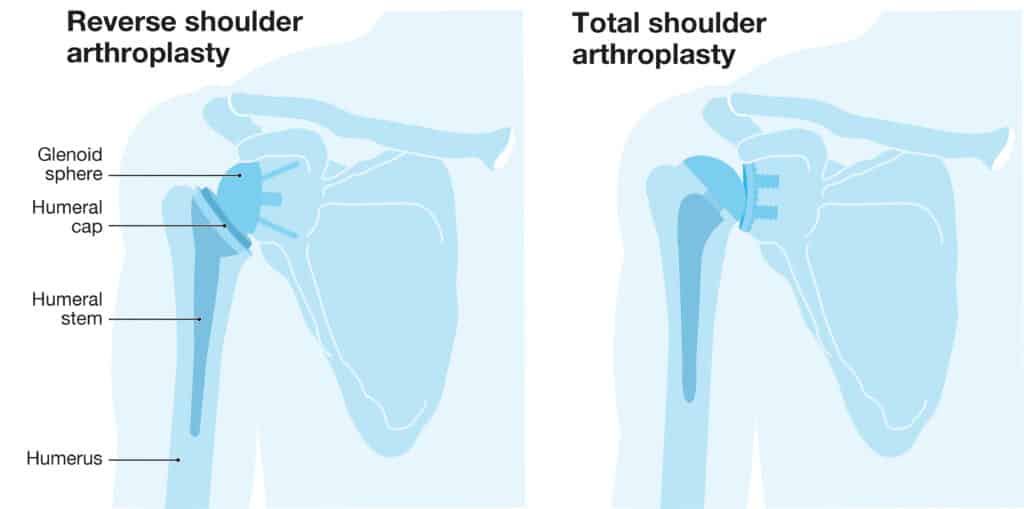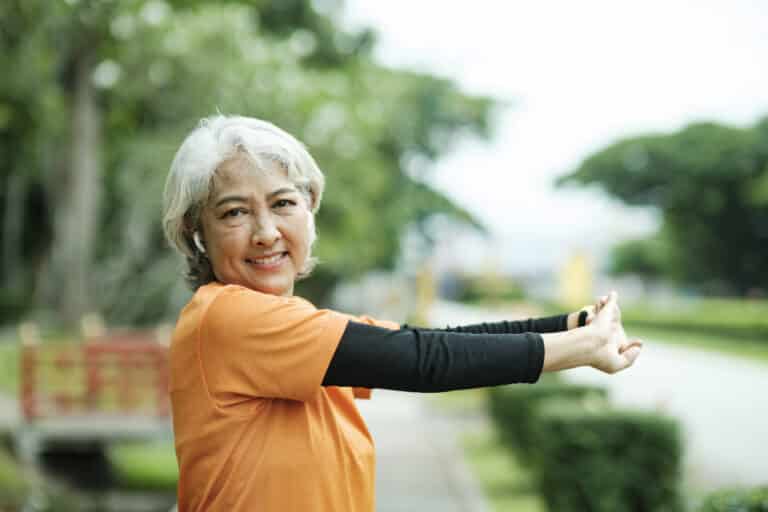Are you an older adult who suffers from chronic shoulder pain or disability? If so, your doctor may have mentioned surgery as a possible solution. This article details what you can expect from shoulder replacement surgery recovery time.
But what is shoulder replacement surgery? How long is the recovery? Will you be able to return to your favorite activities afterward? If you’ve considered this option, you’ve probably heard a lot of mixed information about shoulder replacement surgery and have questions like these.
As a physical therapist with plenty of experience helping older adults recover from surgery, I will answer some of these questions so that you can make more informed decisions about the health of your shoulders. I’ll break down the basics of shoulder replacement surgery, the entire recovery process, and how you can optimize your self-care techniques to get the best results possible.
What is Shoulder Replacement Surgery?

Shoulder replacement surgery, also known as total shoulder arthroplasty, is a surgical procedure that replaces your damaged shoulder joint with an artificial one made of metal and plastic (1). The main goal of shoulder replacement surgery is to relieve pain, improve shoulder function, and enhance quality of life.
Types of Shoulder Replacement
There are different types of shoulder replacement surgery, depending on the extent and location of your shoulder damage. The following are the most common types of shoulder replacement.
Total shoulder replacement
This surgery replaces your shoulder joint’s ball (humeral head) and socket (glenoid) with artificial components that mimic their natural shape and size.
Reverse total shoulder replacement
This type of surgery switches the positions of the ball and socket in your shoulder joint, placing the ball on the socket side and the socket on the ball side. This creates a more stable joint that can be moved even if some of the essential muscles in your shoulder are torn.
Partial shoulder replacement
This surgery replaces only the ball or the socket of your shoulder joint, leaving the other part intact. This may be an option if you have isolated damage to one part of your joint.

For many of my patients, shoulder replacement surgery is an effective treatment for older adults with severe shoulder damage due to arthritis, injury, or other conditions. According to the American Academy of Orthopaedic Surgeons (AAOS), more than 53,000 people in the US have shoulder replacement surgery each year (2). Even better, most patients undergoing shoulder replacement surgery report significant improvement in pain, function, and satisfaction levels.
However, shoulder replacement surgery is not a quick fix. This major surgery requires a long and gradual recovery, even for otherwise healthy older adults. For this reason, I always educate my patients on the importance of saving total joint replacement surgery as a last resort when all other treatments have been unsuccessful.
To help you better understand the recovery process from shoulder replacement surgery and improve your quality of life afterward, we will go through the process of shoulder replacement recovery step-by-step and give as much detail as possible along the way.
Stage 1: The First Week After Surgery
Your first week after shoulder replacement surgery will surely be your recovery’s most challenging and uncomfortable stage. During this stage, you will experience a high degree of pain, swelling, bruising, and stiffness in your shoulder joint. You will also have a bandage or a dressing covering your wound and a sling or a brace to keep your arm immobilized.
Immediately after surgery, you will be in the hospital for one or two nights, depending on your health and the type of shoulder replacement done. During this time, you will be monitored by a medical team who will check your vital signs and help keep you comfortable. You will also likely be given pain medication through an intravenous (IV) line to help you manage your discomfort as needed.
Going Home After Your Surgery
You can go home once your pain is under control, and you can move around safely. However, you will need someone to drive you home and stay with you during your initial recovery. Generally, I also instruct my patients on setting up their home environment to support their recovery better, such as:
- Moving essential items to a reachable height and within easy access
- Removing any clutter or obstacles that may cause you to trip or fall
- Placing a chair with armrests and a pillow in your living room or bedroom
- Stocking up on easy-to-prepare meals and snacks that you enjoy
You’ll also need to arrange follow-up care with your doctor and physical therapist during this stage. Your first follow-up visit with your doctor is typically within a week after surgery. During this visit, your doctor will examine your wound, remove your stitches or staples, and change your dressing. Your doctor will also give you instructions on caring for your wound and preventing infection.
Many of my patients also start physical therapy within a few days after surgery. Physical therapy is a widely standardized part of recovery that many surgeons recommend to help you regain movement and function in your shoulder joint (3).
Your physical therapist will design a personalized exercise program that will include gentle stretches and exercises to improve your range of motion, strength, and flexibility during the initial recovery phase.
In my experience, it’s also helpful to have the ongoing support of your physical therapist to help you optimize the use of your sling and keep pain under control with minimal medication use.
Best Practices for the First Stage of Recovery
During the first week after surgery, you must cope with the initial discomfort and challenges of having a new shoulder joint. Here are a few tips on how to do that:
- Use ice packs or cold therapy devices to reduce swelling and inflammation in your shoulder. Apply cold for 15 to 20 minutes as needed throughout your day.
- Wear your sling or a brace as your doctor and physical therapist may have initially instructed. A sling will protect your shoulder from accidental movements or bumps that may cause new injury.
- Use pillows or cushions to support your shoulder and arm when sitting or lying down. Your support should keep your arm in a similar position as your sling.
I always recommend following your doctor’s instructions on taking care of yourself after surgery, such as taking your medications as prescribed, keeping your wound clean and dry, avoiding smoking and alcohol, and eating a healthy diet.
These things might seem basic, but they’re essential to making the most out of your recovery.
Stage 2: The Second to Sixth Week After Surgery
Your second to sixth week after shoulder replacement surgery is when you will see improvements in your new shoulder joint. You will also become more active in your physical therapy sessions, which will help you regain some of the normal movement and function in your shoulder joint.
During this stage, you’ll need to attend physical therapy sessions regularly, usually two or three times weekly. During each session, your therapist will introduce new exercises and techniques to help with your recovery.
It’s essential to follow your physical therapist’s advice and feedback carefully. Doing too much can lead to pain or injury while doing too little may delay your recovery and lead to stiffness or weakness in your shoulder.
Best Practices for Stage Two Recovery
During this stage of recovery, you will still need to follow the activity limitations and precautions assigned to you by your surgeon to protect your shoulder joint. Here are a few to keep in mind:
- Continue to wear the sling provided by your doctor and use it according to the advice of your physical therapist.
- Do not lift anything heavier than a book or a plate of food with your operated arm until your physical therapist has instructed you to do the proper exercises.
- Do not reach across your body or behind your head with your surgical arm, as these movements still stress your new shoulder joint.
- Only drive once cleared by your doctor. Driving may require you to move your shoulder joint in ways that may be unsafe or uncomfortable for you, so it’s essential to take your time with returning to this specific activity.
Here are a few of the self-care techniques that I often focus on with my older adult patients who are recovering from surgery:
Apply heat or cold therapy to your shoulder as needed for pain management. Heat therapy can help relax your shoulder muscles and improve blood flow to the area. In contrast, cold therapy can help reduce swelling and inflammation in the area.
Do gentle stretches and exercises at home as instructed by your physical therapist. The right exercises can help you improve your shoulder range of motion, strength, and flexibility to enhance the recovery of your shoulder joint.
Massage your scar tissue to prevent adhesions. Adhesions are bands of scar tissue that can form around your surgical scar, and regularly massaging your scar tissue can help your scar heal more evenly for better shoulder mobility down the line.
Stage 3: The Seventh to Twelfth Week After Surgery
During this stage, you will increase exercise intensity in your physical therapy sessions and resume some of your daily activities with appropriate modifications.
Going into this stage of recovery, many of my patients will stop using their shoulder slings. Keep in mind that the timeline for discontinuing the use of a shoulder sling varies between patients, so this decision should be based on your progress and the opinion of your care team.
During this stage, your physical therapy will likely focus more on activities that can be done at home. With weekly or biweekly appointments, your therapist can evaluate your shoulder condition and progress or adjust your exercise program during each visit. The main goal of your exercise program in this stage is to help you achieve a normal range of motion and strength in your shoulder joint.
By the end of this stage, you should be able to drive, dress, bathe, eat, work, and sleep reasonably normally. However, you may need to modify or adapt some of your activities to avoid straining or injuring your shoulder joint. This is especially true if you have a more physically demanding schedule or job that you need to return to.
As you progress through this stage, you may no longer need a prescription or over-the-counter medication to manage your pain. However, keeping an ongoing conversation with your doctor or pharmacist is essential to ensure you use any medications responsibly.
Best Practices for Stage Three Recovery
Of course, there are still precautions to follow during this stage of recovery. Here are some of the most common that I educate my patients on:
- Avoid very heavy lifting or heavy overhead activities with your surgical arm.
- Don’t participate in contact sports or high-impact exercises, as these can overload your shoulder joint with stress.
- Use caution with sleeping on your surgical side. Sleeping on your operated side will compress your shoulder joint and make some people uncomfortable.
It’s easy to become so focused on your rehabilitation program after surgery that many older adults overlook their basic health and wellness routine. For this reason, I recommend focusing on getting good sleep, prioritizing a healthy diet, and getting some low-impact cardiovascular exercise regularly, such as walking.
Stage 4: The Thirteenth Week After Surgery Onwards

Your thirteenth week after surgery is the stage where you will (hopefully) start to experience the full benefits of your shoulder replacement surgery. Many of my patients achieve a near-full range of motion and strength during this stage, gradually returning to their normal lifestyle and decreasing the need for regular physical therapy.
Most patients typically stop attending physical therapy regularly by the end of their twelfth week, but continuing to work on a home exercise program is critical for your long-term recovery. For many otherwise healthy seniors, this means returning to a regular exercise routine that helps you stay active over the years.
At this point in recovery, most of my patients can drive, dress, bathe, eat, work, and sleep normally. Typically, this also means participating in some of your favorite recreational activities that do not involve heavy lifting or overhead movements, such as golf, swimming, or biking.
Best Practices for Long-Term Recovery
As you become more independent and confident after recovering from surgery, here are a few things to keep in mind for the future:
- Focus on the gradual progression of activity. Take things one day at a time and slowly add weight, time, and intensity to your exercise or recreation.
- Avoid high-impact activities or contact sports where possible. If you need to participate in these activities, continue working with a specialized coach who can help you reduce your risk of injury as much as possible.
- Do not ignore any signs of pain or discomfort in your shoulder. Don’t hesitate to contact your primary care doctor or physical therapist for more help when something doesn’t feel right.
As a physical therapist who has worked with many older adults recovering from surgeries, I always encourage working with multiple healthcare providers throughout your shoulder replacement surgery recovery time to get the best results possible.
This could be a combination of your surgeon, primary care doctor, physical therapist, and psychologist. This is your care team, and they are dedicated to providing you with the best possible tools for a positive outcome from your procedure.
Key Takeaways
- Shoulder replacement surgery is a common and often effective treatment for older adults who have severe shoulder damage due to arthritis, injury, or other major health conditions.
- Recovery from shoulder replacement surgery can be divided into four stages, each with different activity limitations, self-care recommendations, and physical therapy goals.
- Pain management, improved strength and range of motion, gradual return to physical activity, and complication prevention are the key aspects of your recovery after shoulder replacement surgery.
- By following your doctor’s instructions and taking care of yourself along the way, shoulder replacement surgery can improve your quality of life and enjoy better shoulder function and mobility as an older adult.
- Always remember that joint replacement surgery is serious and involves a long recovery. These surgeries should not be used until all other forms of treatment have been unsuccessful.
References
- Sanchez-Sotelo J. Total shoulder arthroplasty. Open Orthop J. 2011 Mar 16;5:106-14. doi: 10.2174/1874325001105010106. PMID: 21584206; PMCID: PMC3093753.
- American Academy of Orthopedic Surgeons: Shoulder Joint Replacement
- Edwards, P. K., Ebert, J. R., Littlewood, C., Ackland, T., & Wang, A. (2020). Effectiveness of formal physical therapy following total shoulder arthroplasty: A systematic review. Shoulder & elbow, 12(2), 136–143. https://doi.org/10.1177/1758573218812038






